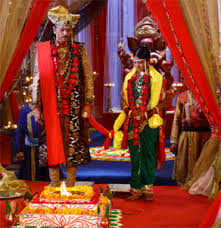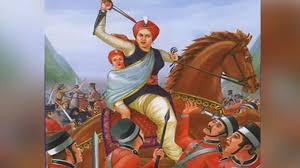RANI LAKSHMIBAI
By nidhisinghrajput1998vns | — | May 17, 2025
.jpg)
Rani Lakshmibai – The Fierce Queen of Jhansi
Rani Lakshmibai, also known as the Queen of Jhansi, is one of the most celebrated figures in Indian history. Her bravery, leadership, and unyielding spirit during India’s First War of Independence in 1857 made her a national hero and a symbol of resistance against British colonial rule. Born as Manikarnika Tambe, her transformation from a young girl into a warrior queen is a story of courage, determination, and patriotism.
Early Life:-

Rani Lakshmibai was born on November 19, 1828, in Varanasi (then known as Kashi or Banaras), a culturally rich city in northern India. She was named Manikarnika and was fondly called Manu by her family and close friends.
Her father, Moropant Tambe, was a court official in the Peshwa’s court, and her mother, Bhagirathi Bai, passed away when Manu was very young. Her father raised her in the household of Peshwa Baji Rao II in Bithoor, where she grew up among boys and was encouraged to learn skills typically reserved for warriors.
Manikarnika was educated in literature, philosophy, and history. She was also trained in martial arts, horse riding, fencing, and shooting. Her upbringing fostered independence and a deep sense of duty towards her people and country. From an early age, she displayed traits of leadership and resilience that would later define her reign as the Rani of Jhansi.
Marriage and Entry into Royalty:-

In 1842, at the age of 14, Manikarnika married Maharaja Gangadhar Rao, the king of the princely state of Jhansi, located in present-day Uttar Pradesh. Upon marriage, she was given the name Lakshmibai. The marriage brought her into a world of royal responsibility and politics. Despite being young, she adapted quickly and proved herself to be intelligent and resourceful.
In 1851, Lakshmibai gave birth to a son named Damodar Rao, who unfortunately died within a few months. The couple then adopted a relative’s son, Anand Rao, who was renamed Damodar Rao, as their legal heir shortly before Gangadhar Rao's death in 1853.
Doctrine of Lapse and Conflict with the British:-
After the death of Maharaja Gangadhar Rao, the British East India Company, under Governor-General Lord Dalhousie, invoked the Doctrine of Lapse, which stated that if a ruler died without a biological heir, their kingdom would be annexed by the British. The British refused to recognize the adopted Damodar Rao as the legitimate heir to the throne and decided to annex Jhansi.
Rani Lakshmibai strongly protested this decision. She wrote letters and appeals to the British authorities, arguing the legitimacy of the adoption, but her pleas were ignored. Jhansi was declared annexed in 1854. Lakshmibai was asked to leave the palace and was offered a pension, which she initially accepted under duress. However, she never gave up her claim to the throne or her commitment to her people. Lakshmibai was asked to leave the palace and was offered a pension, which she initially accepted under duress. However, she never gave up her claim to the throne or her commitment to her people.
The Rebellion of 1857:-

The discontent that had been brewing across India due to British policies, exploitation, and disrespect for Indian traditions erupted in 1857 in the form of a widespread rebellion. Also known as the First War of Indian Independence, this movement saw Indian soldiers (sepoys), princes, and commoners rise up against British rule.
Rani Lakshmibai emerged as a key figure in this uprising. When the rebellion reached Jhansi in June 1857, the local British officers were killed by mutineers. Although the Rani initially took control of Jhansi to restore order and protect her people, she was soon branded a rebel by the British, who believed she was complicit in the violence.
Lakshmibai began to prepare for war. She organized an army, which included both men and women, and trained them rigorously. Her forces were made up of brave warriors such as Tatya Tope, Rao Sahib, and Rani’s trusted general Ghulam Ghaus Khan. She established factories to manufacture arms and strengthened the defenses of her fort.
The Siege of Jhansi
In early 1858, British forces under General Sir Hugh Rose advanced toward Jhansi. The siege began in March and lasted for several weeks. Rani Lakshmibai defended the fort with extraordinary courage and strategy, refusing to surrender despite being heavily outnumbered and outgunned.
When the British forces eventually breached the walls of the fort in April 1858, the Rani escaped with her son Damodar Rao and a small group of loyal soldiers. She mounted her horse, tied her son to her back, and galloped out of the fort under heavy fire — an act that has become legendary in Indian history.





.jpg)
.jpg)



